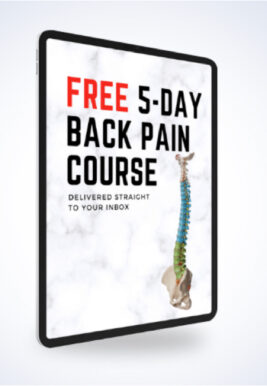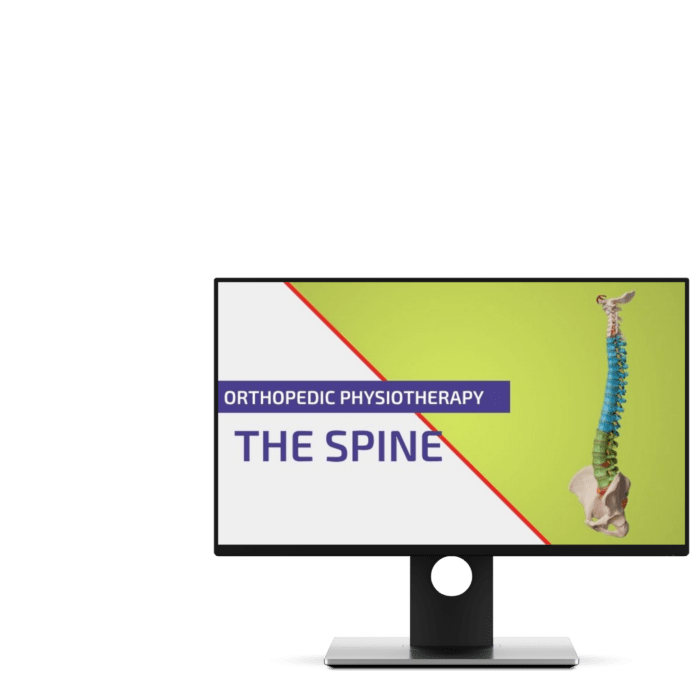Lumbar Spinal Stenosis | Diagnosis & Treatment for Physios

Lumbar Spinal Stenosis | Diagnosis & Treatment for Physios
 Lumbar Spinal Stenosis (LSS) describes an anatomical narrowing of the spinal canal with subsequent neural compression and is frequently associated with symptoms of neurogenic claudication. A normal anterior-to-posterior (AP) diameter of the spinal canal is somewhere between 22-25mm. In relative LSS, this diameter has narrowed down to 10-12mm. This presentation is often asymptomatic. Absolute LSS shows a spinal canal with an AP diameter of less than 10mm and is often symptomatic.
Lumbar Spinal Stenosis (LSS) describes an anatomical narrowing of the spinal canal with subsequent neural compression and is frequently associated with symptoms of neurogenic claudication. A normal anterior-to-posterior (AP) diameter of the spinal canal is somewhere between 22-25mm. In relative LSS, this diameter has narrowed down to 10-12mm. This presentation is often asymptomatic. Absolute LSS shows a spinal canal with an AP diameter of less than 10mm and is often symptomatic.LSS can also be classified according to its anatomy. LSS can be monosegmental or multisegmental, and unilateral or bilateral and occur centrally, laterally in the recess or the intervertebral foramen (Siebert et al. 2009). In this post, we will focus on central canal stenosis, which can lead to neurogenic claudication by a compression of the cauda equina. So when we talk about LSS in the following we are referring to the central canal.
Lateral recess stenosis and interforaminal stenosis will have different signs & symptoms. In these instances, not the myelum, but the spinal nerve roots are compressed leading to lumbosacral radicular syndrome (see previous unit). While in lateral stenosis, the patient typically complains of severe radiating pain during the day that keeps him up at night, foraminal stenosis is influenced by the position of the spine. Lumbar flexion leads to an average of 12% increase in the foraminal area and thus decreases radicular symptoms, while lumbar extension decreases the foraminal area by 15%, which leads to an aggravation of pain and radiculopathy. Jenis et al. (2000) describe that the most common roots involved were L5 (75%), followed by L4 (15%), L3 with 5.3%, and L2 with 4%. The distribution of prevalence is explained by the relation between the size of the foramen and the nerve root/dorsal root ganglia (DRG) cross-sectional areas. The lower lumbar and sacral roots and DRG are larger in diameter, leading to a smaller foramen-to-root ratio. On top of that, the highest static and dynamic compression take place at segments L4/L5 and L5/S1.
Multiple factors can contribute to the development of spinal stenosis, and these can act synergistically to exacerbate the condition (Siebert et al. 2009):
- Degeneration of the vertebral disc often causes a protrusion, which leads to ventral narrowing of the spinal canal
- As a consequence of disc degeneration, the height of the intervertebral space is further reduced, which causes the recess and the intervertebral foramina to narrow, exerting strain on the facet joints
- Such an increase in load can lead to facet joint arthrosis, hypertrophy of the joint capsules and the development of expanding joint cysts (lateral stenosis)
- The reduced height of the segment causes the ligamenta flava to form creases, which exert pressure on the spinal dura from the dorsal side (central stenosis)
- Concomitant instability due to loosened tendons (e.g. the ligamenta flava) further propagates preexisting hypertrophic changes in the soft tissue and osteophytes, creating the characteristic trefoil-shaped narrowing of the central canal
Epidemiology
The annual incidence of LSS is 5 in 100.000 individuals, which is fourfold the incidence of stenosis occurring in the cervical spine. Among older individuals, LSS is the most common reason for surgery (Siebert et al. 2009).
Jensen et al. (2020) conducted a systematic review and meta-analysis of the prevalence of LSS in the general and clinical population. They found a pooled prevalence of 11% of clinical symptoms of LSS in the general population with a mean age of 62. In patients in a primary care setting with a mean age of 69, this number rose to 25% and even 39% in secondary care and a mean age of 58.
The authors also found that 11% of healthy subjects with a mean age of 45 and 38% in general populations with a mean age of 53 had a radiological diagnosis of LSS. The prevalence rates of LSS increase with age with an increase starting as early as 40 years of age.
Follow a course
- Learn from wherever, whenever, and at your own pace
- Interactive online courses from an award-winning team
- CEU/CPD accreditation in the Netherlands, Belgium, US & UK
Clinical Presentation & Examination
Classical symptoms of LSS are described to be unilateral or bilateral (exertional) back and leg pain. The back pain is localized in the lumbar spine and can radiate towards the gluteal region, groin, and legs, frequently displaying a pseudoradicular pattern (see our unit on aspecific low back pain). Due to neurogenic claudication, leg symptoms can include fatigue, cramps, heaviness, weakness and/or paresthesia, ataxia, and nocturnal leg cramps (Siebert et al. 2009).
De Schepper et al. (2013) conducted a systematic review evaluating the accuracy of different items from patient history and clinical tests to diagnose LSS. They found that radiating leg pain that is exacerbated while standing up, the absence of pain when seated, improvement of symptoms when bending forward, and a wide-based gait are most useful to reach a diagnosis. Cook et al. (2019) add that numbness in the perineal region was of diagnostic value as well.
These findings are very similar to the clinical prediction rule of Cook et al. (2011) to diagnose LSS:
Genevay et al. (2018) defined criteria that independently predicted neurogenic claudication due to LSS that can help to distinguish this diagnosis from radicular pain caused by disc herniation and aspecific low back pain. A classification score using a weighted set of these criteria was developed. The proposed N-CLASS score ranged from 0 to 19 with a cutoff (>10/19) to obtain a specificity of >90.0% and a sensitivity of 82.0%. The items that the authors found were:

Examination
Cook et al. (2019) conducted a systematic review of the diagnostic accuracy of patient history, clinical findings, and physical tests in the diagnosis of lumbar spinal stenosis. They found 3 physical tests to be useful in the diagnosis of LSS:
The Marching test was originally described by Jensen et al. (1989). With a sensitivity of 63% and a specificity of 80%, this test is moderately useful to confirm, but not to exclude lumbar spinal stenosis. To conduct the test, have a patient walk on a treadmill at a speed of 1.8km/h and a maximum walking time of 15 minutes but shortened according to the symptoms of the tested person. The rear end of the treadmill is elevated to create a 10-degree downward slope in the walking direction to exaggerate the lumbar lordosis of the tested subject. This diminishes the square area of the spinal canal. The test is considered positive if a “symptom-march” is exhibited which means that the patient reports discomfort during the activity with an extension of symptoms into the lower extremities.
In case you suspect foraminal stenosis in your patient, Kemps Test can help you to decrease the interforaminal area and entrap the nerve, thus provoking symptoms. Unfortunately, this test has not been evaluated regarding its accuracy to confirm or rule out foraminal stenosis.
Clinically, LSS can further be classified into 3 grades according to neurological deficits:

There is a lot of discussion going on about the reliability of dermatome maps. Check out our blog articles and research reviews if you want to learn more about it:
It is important to distinguish between neurogenic intermittent claudication and vascular claudication. The following table will show you the differences between the 2 conditions:

Nadeau et al. (2013) have compared individual signs & symptoms regarding their ability to distinguish between the 2 conditions. They found that pain alleviators and symptom location had weak clinical significance for neurogenic claudication and vascular claudication. The most distinguishing features of a neurogenic origin were:
- A positive shopping cart sign
- Symptoms located above the knees
- Provocation with standing and relief with sitting had a strong likelihood.
Combining those features yielded a positive likelihood ratio of 13. Patients with symptoms in the calf that were relieved with standing had a strong likelihood of vascular claudication (LR+ 20).
Be aware, that there can be other underlying reasons for nerve root entrapment than a herniated disk. On top of that, pain radiating to the proximal leg could also be referred pain instead of radicular pain. For more information check out the following videos:
- Lumbar Radicular Pain vs. Referred Pain
- Lumbar Radicular Syndrome vs. Intermittent Neurogenic Claudication from Lumbar Spinal Stenosis
MASSIVELY IMPROVE YOUR KNOWLEDGE ABOUT LOW BACK PAIN FOR FREE

Follow a course
- Learn from wherever, whenever, and at your own pace
- Interactive online courses from an award-winning team
- CEU/CPD accreditation in the Netherlands, Belgium, US & UK
Treatment
Slater et al. (2015) looked at the efficacy of exercise for LSS and the authors have good news: Exercise appears to be an efficacious intervention for pain, disability, and analgesic intake. Additionally, exercise was able to reduce depression, anger, and mood disturbance among patients with LSS. Further research suggests that a supervised exercise program is superior to a home-exercise program and that exercising twice a week yields superior outcomes compared to only once a week (Minemata 2019a, Minemata 2019b). Macedo et al. (2013) conducted a review of physical therapy interventions for LSS and found low-quality evidence suggesting that modalities have no additional effect to exercise.
Schneider et al. (2019) compared a combination of manual therapy and individualized exercise to medical care and group exercises. They found that MT/individual exercise provided greater short-term (2 months) improvement in symptoms, physical function, and walking capacity than medical care or group exercises, although all 3 interventions were associated with improvements in long-term (6 months) walking capacity. In the following tabs, we will show different treatment options similar to the exercise/MT program by Schneider et al. (2019).
As always: your treatment choices for your individual patient should be based on the findings from patient-history taking and examination, as well as negative prognostic factors that are present in order to make it specific to the patient in front of you.
Although advice and education are always important, it seems that understanding the pathophysiology of LSS is especially important for the patient and family members. While a forward-flexed posture might not be desirable from a cosmetic point-of-view, patients and their spouses should understand that this posture is beneficial in order to decrease pressure on the cauda equina and spinal nerves. An RCT by Comer et al. (2019) then also found that a physiotherapist-described home exercise program is not more effective than advice and education. One can ask if this is due to the low efficacy of home exercises or due to the fact that advice and education are that important.
Long et al. (2004) investigated if exercises that are matched to patients’ directional preference (DP) are superior to unmatched exercises. In 74% of patients with a directional preference, they found that exercises matching subjects’ DP significantly and rapidly decreased pain and medication use and improved all other outcomes compared to the non-matched group.
Longtin et al. (2018) examined if patients with LSS have a directional preference for flexion direction exclusively. They found that a high proportion of patients with LSS presented a directional preference (88.9%), which confirms the mechanical aspect of this type of low back pain. Not surprisingly most patients with LSS in the study, about 80% (19/24), had a DP in flexion (repeated lumbar flexion exercises reduced their symptoms). These results support the theoretical biomechanical principle: by augmenting the spinal canal lumen via flexion of the lumbar spine, flexion-based exercises may alleviate the symptoms of LSS by decreasing “pressure” on the spinal structures. They also provide evidence in part for why clinicians often use flexion-based treatments without further investigation when treating patients with signs of LSS, because most of the time, patients do obtain pain relief with lumbar flexion.
Similar to direction-specific exercises, passive lumbar mobilization can help to relieve symptoms in LSS, but also foraminal stenosis on short-term:
Passive hip mobilization into extension is a way to decrease hip stiffness and to thus increase hip extension range of motion (Whitman et al. 2003). Increased ROM in hip extension may decrease compensatory lumbar spine extension during gait and thus decrease compression of the cauda equina and spinal nerves in LSS. Furthermore, increased hip extension enables the patient to increase step length and walking speed.
Surgical Treatment
If we look at the course of LSS, a great number of patients do not seem to get worse over time and might actually see improvements. However, approximately 30% will worsen over a period of 11 years and might develop severe symptoms of neurogenic claudication. These cases are often referred for surgery and LSS is the number 1 reason for surgery in the elderly (Siebert et al. 2009). But how effective is surgery really? Mo et al. (2018) performed a systematic review and meta-analysis and observed a trend that exercise therapy had a similar effect on lumbar spinal stenosis compared with decompressive laminectomies. Minemata et al. (2018) specifically compared physiotherapy to surgery in patients who did not report success with physiotherapy. They concluded that at 2 years, the outcomes except for the change in physical function score in the ZCQ subscale did not differ significantly between patients who had undergone surgery and those who avoided surgery.
On the other hand, a recent study by Held et al. (2019) showed that patients with nonoperative treatment had lower quality of life and function compared to patients undergoing surgery at the 12-month follow-up. So if a patient suffers for a long time and conservative therapy does not show the desired results, surgery might be indicated.
What other factors might determine who could benefit from surgery? Iderberg et al. (2019) have examined which factors determine success after surgery and found that the following factors predicted good function: being born in the EU, reporting no back pain at baseline, having a high disposable income, and having a high educational level. On the other hand, factors predicting a worse outcome were previous surgery, having had back pain for more than 2 years, having comorbidities, being a smoker, being on social welfare, and being unemployed.
References
Jenis, L. G., & An, H. S. (2000). Spine update: lumbar foraminal stenosis. Spine, 25(3), 389-394.
Follow a course
- Learn from wherever, whenever, and at your own pace
- Interactive online courses from an award-winning team
- CEU/CPD accreditation in the Netherlands, Belgium, US & UK
Finally! How to Master Treating Spinal Conditions in Just 40 Hours Without Spending Years of Your Life and Thousands of Euros - Guaranteed!


What customers have to say about this course
- Shachaf Alexander19/07/24Orthopedic Physiotherapy of the Spine Orthopedic Physiotherapy of the spine
Interesting course packed with useful data and practical tools.
I highly recommend.Verena Fric25/11/22Orthopedic Physiotherapy of the Spine GREAT COURSE ABOUT THE SPINE
great course, best overview about the different syndromes of the spine, very helpful and relevant for the work with patients - Peter Walsh01/09/22Orthopedic Physiotherapy of the Spine 5 starsChristoph21/12/21Orthopedic Physiotherapy of the Spine Really a well done course, using the modern ways of teaching. Compliments! Sometimes for me you entered too much into details instead of touching more important chapters of Spine treatment like techniques for the treatment of muscles and fascias
- John09/10/21Orthopedic Physiotherapy of the Spine EXCELLENT COURSE HIGHLY RECOMMEND
As a newly graduated physiotherapist i highly recommend this course just to know you are on the right track with your patients. the information presented is very clear and easy to follow as well as the great physiotherapy style videos. It makes learning actually fun , thanks guys for all your hard work. Well deserved.Alexander Bender06/09/21Orthopedic Physiotherapy of the Spine During the corona crisis, I booked many online courses and webinars, but none were as entertaining and well thought out as PhysioTutors’ courses.
All units are well summarized, meaningfully broken down and easy to understand.
I am looking forward to the other courses.
Many greetings from Germany. - GHADEER05/01/21Orthopedic Physiotherapy of the Spine VERY INFORMATIVE AND UPDATED
for anyone who is lost in handling spine cases, this course is very helpful.MICHAEL PROESMANS20/12/20Orthopedic Physiotherapy of the Spine HIGHLY METHODICAL, WITH PLENTY OF SCIENTIFIC REFERENCE
Clear, structured and well researched course concerning most common pathologies of the spinal complex.
Plenty of informative modules, with detailed video-analysis.
If you’re looking for a course to study in your own time, with enough depth and scientific background, then you’ve found a very good one here.
Bang for buck, a great course. - BENOIT08/05/20Orthopedic Physiotherapy of the Spine After finishing the Orthopedic course for Lower & Upper limbs, I was looking forward to begin this Spine specific course.
Really good overview about all spine pathologies from epidemiology to diagnosis & treatment which made me more confident to care for my future patients.
ANOTHER GREAT COURSE !
The courses are well detailed with lot of informations and videos.
For me these 2 courses are must to see to learn and update knowledge for most common pathologies in Physiotherapy.Nicolas Cardon27/04/20Orthopedic Physiotherapy of the Spine This is a very interesting course !
We can find many informations about the main pathologies and their differential diagnosis and about objective and subjective exam. Videos are clear and well designed.
It’s a very well course for these who wish complete their Orthopedic Manual Therapy curriculum.
A French Physio’







